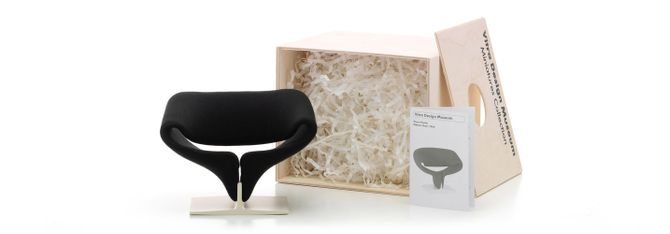
Miniatures Collection - Ribbon Chair
Pierre Paulin, 1966
The seat, backrest and armrests of the chair have a unified metal frame that is completely covered with foam upholstery and stretch fabric. The seat is mounted on a lacquered pedestal made of pressed wood. The de-velopment of the Ribbon Chair was facilitated by technological innovations during the Sixties, which led to the production of inexpensive synthetic foams. This period also saw the introduction of novel elastic fabrics that could be used to envelop a complex contoured shape without folds or intricate seams. The biomorphic, slightly resilient seat of the Ribbon Chair allows a wide variety of sitting positions and provides a high degree of seating comfort.
Informations
| Titre | Langue | File | |
|---|---|---|---|
| Fiche Produit | DE | PDF, 786 kB | Télécharger |
Miniatures Collection
Depuis plus de 20 ans, le Vitra Design Museum reproduit en miniature les jalons de l'histoire du design de mobilier de sa propre collection. La Miniatures Collection englobe toute l'histoire du mobilier industriel – de l'historicisme et de l'Art Nouveau au Bauhaus et à la Nouvelle Objectivité, du Radical Design et du Postmodernisme à nos jours. Les chaises sont reproduites à l'échelle un sixième et reproduisent fidèlement l'original historique jusqu'au moindre détail de conception, de matériau et de nuance de couleur. Cette précision des détails s'applique aussi aux nervures du bois, à la reproduction des vis ou aux méthodes minutieuses de la fabrication artisanale. Ces miniatures sont non seulement de précieux objets de collection, mais également un support pédagogique pour les universités, les écoles de design et les architectes.